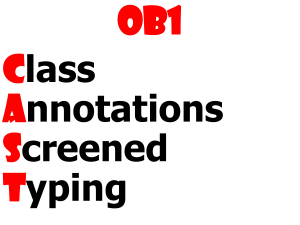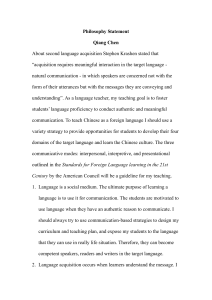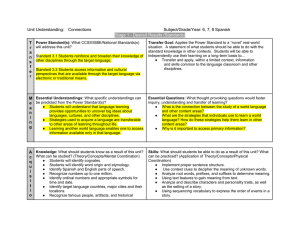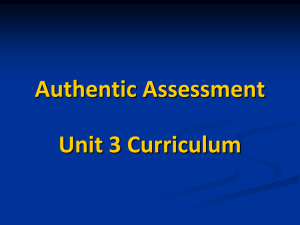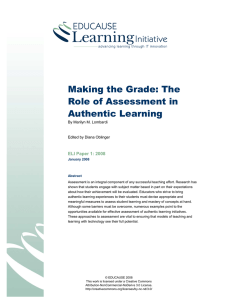DESIGNING AND USING AUTHENTIC ASSESSMENT OF
advertisement
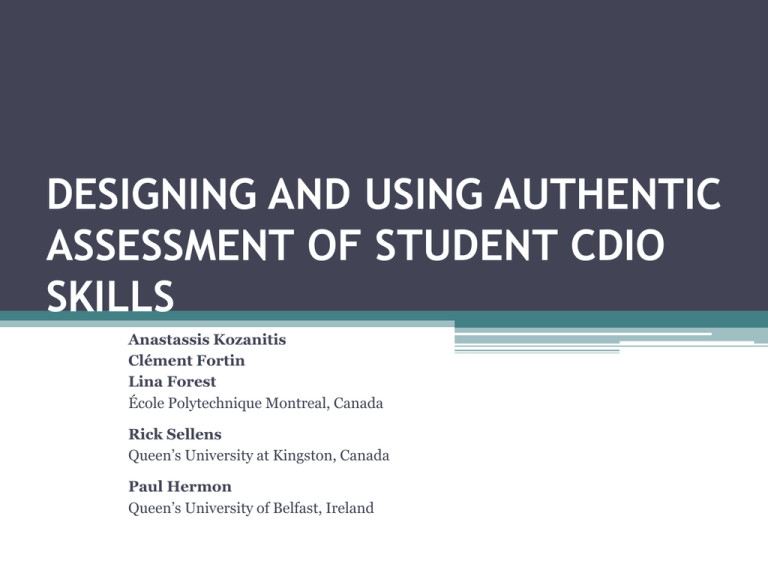
DESIGNING AND USING AUTHENTIC ASSESSMENT OF STUDENT CDIO SKILLS Anastassis Kozanitis Clément Fortin Lina Forest École Polytechnique Montreal, Canada Rick Sellens Queen’s University at Kingston, Canada Paul Hermon Queen’s University of Belfast, Ireland CONTENTS • What is authentic assessment? • Why use authentic assessment? • How to use authentic assessment process of competencies? • What are the limits and issues related to authentic assessment? WHAT IS AUTHENTICITY? • Realistic situations; • Contextualized and relatively complex tasks • Tasks and problems refer to the reality of the professional life or to everyday life; • Students must combine knowledge, skills and attitudes in order to solve the problems; • Requires judgement and innovation. • Huba, M. & Freed, J. (2000) WHY AUTHENTICITY? • Coherent way to assess learning outcomes (process and results). • Can assess the three types of knowledge (factual, procedural, and conditional). • Taps into Bloom’s higher order cognitive objectives (analysing, evaluating, and creating). • Relevant when there is not ONE good answer. • Students can show what they know and what they can do with their knowledge. Five step process for designing effective authentic assessment Organizing and planning the process Continuously improving the process Allotting a grade Conceiving and producing the instruments Foreseeing feedback mechanisms EXAMPLES OF INSTRUMENTS • • • • • • • • team projects, professional work simulations, case studies, long answer exams within a professional setting, clinical evaluations, artistic creations, mock trials, internships, etc. Two important elements to consider • 1) Writing the performance task, • 2) Building the rubric(s). Remote-controlled crack monitoring system (Drexel University) • Summary: • The project improves the RCCM Video System used for nondestructive monitoring of fatigue cracking in the unique fuselage panel testing facility at FAA Technical Center near Atlantic City International Airport. • The new system adds functionality to make crack measuring quicker and easier while maintaining accuracy. • The system consists of a single computer with dual monitor output, one for the software control center, and one for the video feeds. The software controls the movement of two video cameras, it captures the video output, supports crack measurement, and manages archiving and retrieval. RUBRIC • A rubric usually contains information allowing students to know what is expected from them, and providing descriptive feedback that helps them improve performance (Prégent, Bernard, & Kozanitis, 2009). ADVANTAGES • Students get regular, project specific feedback from both the client and the supervisor and must resolve potentially differing opinions, making it clear there’s no single right answer. • Multiple iterations are possible on the same design issue. • • Supervisors get personally invested in the success of the team and the individual team members thus the normative evaluations flow much as real world guidance from an immediate supervisor or senior colleague would. • • Final course marks are determined in ways similar to success in employment. SOME POSSIBLE LIMITS • Can supervisors and clients who are personally invested in the project be expected to be fully objective in assessing its success? • Can anybody directly involved be expected to be fully objective on the relative contributions of the various team members? • Can discrepancies in contributions be fully reflected in final course mark variations within teams? • Will varying supervisor bias colour the scores between teams? SOME ISSUES • Costly in the time of both the supervisors and the independent secondary evaluators (high enrolment). • • It is not feasible for the supervisors to be with all of the groups they are involved with all of the time. • Students often see the evaluation process as unfair and different students have different ideas of what would be fair. • • With clients and projects varying among teams and from year to year it is difficult to assess the general quality of the learning experience, or the resulting learning outcomes as they are intentionally not uniform. CONCLUSION • Authentic assessment of CDIO competencies proposes to move away from traditional practices which far too often require from students the repetition of an awaited good answer or learned “by heart” answers, as students say so themselves. References • Prégent, R., Bernard, H., & Kozanitis, A. (2009). Enseigner à l’université dans une approcheprogramme. Montréal: Presses internationales Polytechnique. (Teaching at university within a program-approach). • Huba, M. & Freed, J. (2000). Learner-Centered Assessment on College Campuses. Shifting the Focus from Teaching to Learning. Boston: Allyn and Bacon.

